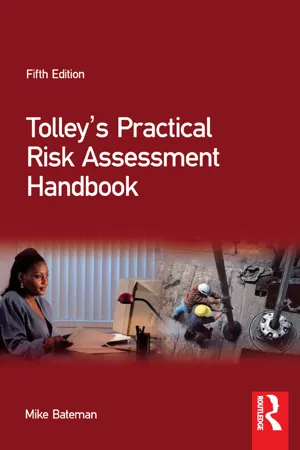
- 384 pages
- English
- ePUB (mobile friendly)
- Available on iOS & Android
Tolley's Practical Risk Assessment Handbook
About This Book
Risk assessment has become the backbone of health and safety management in the UK and elsewhere. Employers have a legal duty to prove that risk assessments have been carried out and to ensure that appropriate precautions have been implemented.
Mike Bateman demystifies the risk assessment process and how it relates to UK legislation. He covers both the general techniques and the assessment of specific risks, such as hazardous substances (COSHH), noise, manual handling, Display Screen Equipment (DSE) workstations, Personal Protective Equipment (PPE), fire, asbestos and work at height. The book is practical in its approach to risk assessment rather than being overly legalistic or academic and tells the reader how to go about risk assessment, not just what the legislation requires. It contains numerous checklists, forms and worked examples for a variety of hazards and industries.
This edition has been fully updated to take into account the impact of the following requirements on risk assessments:
- Work at Height Regulations 2005 – full new chapter
- Control of Noise at Work Regulations 2005
- Regulatory Reform (Fire Safety) Order (RRFSO) 2006
Mike Bateman runs his own health and safety consultancy and specialises in risk assessments. He is a corporate member of IOSH and a registered health and safety practitioner.
Frequently asked questions
Information
1 Introduction
The background to risk assessment | 1.1 |
Key requirements of HSWA 1974 | 1.2 |
What is ‘reasonably practicable’? | 1.3 |
Practicable and absolute requirements | 1.4 |
The Management of Health and Safety at Work Regulations (SI 1999 No 3242) | 1.5 |
Regulations requiring risk assessment | 1.6 |
Control of Substances Hazardous to Health Regulations 2002 (SI 2002 No 2677) (COSHH 2002) | 1.7 |
Control of Noise at Work Regulations 2005 (SI 2005 No 1643) | 1.8 |
Manual Handling Operations Regulations 1992 (SI 1992 No 2793) | 1.9 |
Health and Safety (Display Screen Equipment) Regulations 1992 (SI 1992 No 2792) | 1.10 |
Personal Protective Equipment at Work Regulations 1992 (SI 1992 No 2966) | 1.11 |
Regulatory Reform (Fire Safety) Order 2005 | 1.12 |
Dangerous Substances and Explosive Atmospheres Regulations 2002 (SI 2002 No 2776) (DSEAR) | 1.13 |
Control of Asbestos at Work Regulations 2002 (SI 2002 No 2675) | 1.14 |
Work at Height Regulations 2005 (SI 2005 No 735) | 1.15 |
Control of Lead at Work Regulations 2002 (SI 2002 No 2676) | 1.16 |
Control of Asbestos at Work Regulations 2002 (SI 2002 No 2675) | 1.17 |
Supply of Machinery (Safety) Regulations 1992 (SI 1992 No 3073) | 1.18 |
Control of Major Accident Hazard Regulations 1999 (SI 1999 No 743) (COMAH 1999) | 1.19 |
Ionising Radiations Regulations 1999 (SI 1999 No 3232) | 1.20 |
Control of Vibration at Work Regulations 2005 (SI 2005 No 1093) | 1.21 |
Related health and safety management concepts | 1.22 |
Safe systems of work | 1.23 |
Dynamic risk assessment | 1.24 |
Permits to work | 1.25 |
CDM health and safety plans | 1.26 |
Method statements | 1.27 |
References | 1.28 |
The background to risk assessment
Key requirements of HSWA 1974
- the replacement of specific legal requirements by general obligations;
- legislation to cover everyone at work, including the self-employed (rather than just those in factories, offices, etc. as was previously the case);
- introduction of requirements for employers (and the self-employed) to take account not just of employees but also of others, including the public.
- provision and maintenance of plant and systems of work;
- use, handling, storage and transport of articles and substances;
- provision of information, instruction, training and supervision;
- places of work and means of access and egress;
- the working environment, facilities and welfare arrangements.
What is ‘reasonably practicable’?
Table of contents
- Cover
- Title
- Copyright
- Contents
- Preface
- Foreword
- 1 Introduction
- 2 What the Management Regulations require
- 3 Special cases
- 4 Carrying out risk assessments
- 5 Assessment records
- 6 Model risk assessments
- 7 Specialised risk assessment techniques
- 8 Implementation of precautions
- 9 COSHH Assessments
- 10 Noise assessment
- 11 Assessment of manual handling
- 12 Assessment of DSE workstations
- 13 Assessment of Personal Protective Equipment ( PPE ) requirements
- 14 Fire and DSEAR assessments
- 15 Assessment of risks from asbestos in premises
- 16 Assessment of work at height
- 17 Risk assessment related concepts
- 18 Assessing and managing risk — can you afford not to?
- 19 Looking ahead
- Index